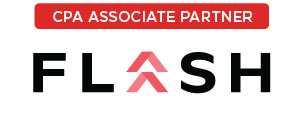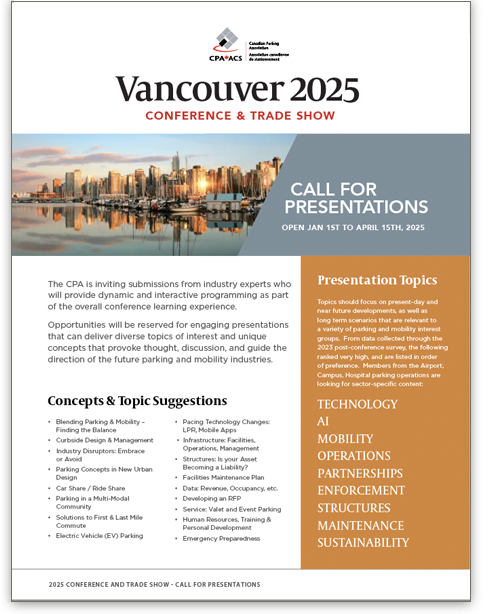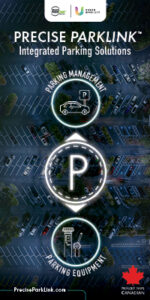Featured in this issue:
- Embryonic Canadian Mobile Payments Market gets Code of Conduct
- Canadian Parking Association Member Profiles
- Green Initiatives: Solar Power Generating Parking Garages
- Who Are You Completing This Street For?
- A Different Look At Single Space Sensors
Welcome to WordPress. This is your first post. Edit or delete it, then start blogging!
As the national organization that facilitates professional development, networking and collaboration amongst Canadian parking professionals, the Canadian Parking Association encourages the use of social media and online information exchanges. You are invited to use The Interchange as an outreach to post your questions and insights and share knowledge with other parking professionals.
To view the most recent posts and add your comments, click on the links in the right column, select a specific sector from the top menu, or submit your question to Canadian Parking Association for posting.
How Mobility and Social Media Will Change the Industry
By Rachel Levy Sarfin
Technology has changed virtually everything we do, from the way we run our businesses to how we communicate with family and friends. So, it should come as no surprise that it has had an impact on parking. The twin phenomena of social media and mobility have had an especial effect on this space.
Social media and mobility have had an influence on parking in Canada, and Canadians are also using these two forms of technology to improve the way we find parking spots and the way we park. The Canadians profiled in this article are using technology to change the way drivers in Canada and around the world park.
If It’s Not on Facebook, It Isn’t True: Social Media and Parking
Some things have not changed, in spite of technology. If you park well, no one will notice, let alone single you out for praise. On the other hand, a bad parking job would merit you a nasty note on the windshield in the days before social media. In today’s world, you would be lucky just to receive an angry Post-It. More likely, a picture of your vehicle will be posted on popular social networking sites for the entire world to see.
Edmonton residents Daniel Huber and Brian LaBelle have harnessed the power of social media to shame drivers who park terribly. In 2014, restaurateur Huber created a Facebook group called “D-BAG ParkJobs.” The group gives metro Edmonton area drivers the opportunity to upload pictures of poorly parked cars to Facebook and write snarky comments.
Shortly thereafter, his friend LaBelle, a certified child and youth counsellor, decided to start a Twitter account devoted to the same subject. The handle is @DBagParkingYEG. Calgary residents began sending in photos, too. LaBelle then launched Twitter accounts…
By Carolyn Krasnow, Ph.D
In recent years, urban planners and community leaders across Canada have turned to “Smart Growth” planning approaches like Complete Streets and New Urbanism to help communities address common challenges associated with downtown planning in the era of the automobile. After decades of urban design focusing on the primacy of the auto, approaches focus on creating communities and streetscapes that provide, among other things, better integration of multi-modal transportation and better walking environments. The point of these planning approaches is to create healthier, less congested and ultimately more livable communities that also foster economic and commercial development.
Arising in the U.S. but quickly becoming international movements, Smart Growth-influenced developments and streetscape upgrades have cropped up throughout Canada. Canadian cities including Mont-Saint-Hilaire in Quebec, Whitehorse in Yukon, and Markham, Ontario have made their communities more walkable and bicycle-friendly, and improved the quality of life for residents. UniverCity in British Columbia and McKenzie Towne in Calgary were created as new communities with sustainable and/or new urbanist principles.
Creating urban environments that have a better balance of transportation modes isn’t as easy as it sounds. Critics of New Urbanism contend that it still accommodates “car culture” more than is desirable, and many people would like to see greatly reduced parking requirements for new developments and cities alike. And given the aging population, decreasing car ownerships trends among younger people, and the rise of car sharing, there is plenty of reason to plan parking with reduced needs in mind. But on the flip side, in most places cars are still the primary form of transportation for most people; not taking them into account adequately can hurt existing businesses and new ones.
A developer we worked with on a transit-oriented development in a vibrant Canadian city came up against this problem as they planned their…
By Ben Smith, B.E.Env
Multi-story parking lots are unique buildings, one in which all elements of the structure are normally exposed to the public. These structures face unique challenges as well as exposure to niche stresses as well as physical and chemical abuse.
Although often underestimated, the correct specification of waterproofing and surfacing materials is critical, within parking environments, to delivering a long-term, structurally protected and safe facility for parking operators and vehicle owners.
The most suitable deck coating material will largely depend on where within the multi-level or underground parking facility they are to be installed as well as the conditions to which the material will be subjected.
This can range from slip-resistance, durability and service life requirements through to temperature cycling, UV exposure and any problematic existing substrate conditions as well as any anticipated movement within the structure.
Parking has become a vital part of today’s mobile world with more vehicles on the road than ever before. As a result, the demand for parking is at an all-time high with vehicle owners searching for secure and safe environments to house their vehicles when they are without them.
The parking lot is often the first point of call for a visitor to any public, private or commercial venue. It is the “front door” of the building, while at the same time serving its primary functional role. There is no doubt that initial appearance, ease of use, signage, bright lighting and clear directional marking all help to make a parking development a more positive and safer environment.
As new build multi-story and underground parking structures are more frequently adorning the urban landscape so too are older structures being renovated to meet both modern design and safety requirements.
One critical design consideration is the deck coating material chosen to protect the reinforced concrete structure, in order to protect…
Wondering if anyone in the industry have tendered for LED conversion for a Parking Structure and if so, would you be willing to share your tender.
Stephane Thibodeau (City of Moncton) | stephane.thibodeau@moncton.ca
The WPA offers residential parking permits which provide residents the ability to park in their specific residential zone and are required to obey all traffic by-laws, including all annual snow route bans, residential parking bans, and public works street works signs for spring and fall street cleaning.
Residential Parking Programs help communities manage non-resident vehicles in their neighbourhood by restricting the amount of time non-residents can park.
The WPA is interested in the following:
- if other cities provide such a permit
- if the permit is a monthly or annual permit
- the cost associated with the permit,
- and if the permit is prorated from the time of purchase
Donna Olson | Winnipeg Parking Authority | dolson@winnipeg.ca







